The Irish Government has launched a new digital mapping project, listing all of the civilian and combatant fatalities of the Irish Civil War.
Minister for Tourism, Culture, Arts, Gaeltacht, Sport and Media Catherine Martin announced the Irish Civil War Fatalities Project on Monday, representing the first systematic attempt to investigate the number of people killed during the Civil War.
Historians have generally been confined to estimates when calculating the human cost of the conflict but can now avail of an academically contextualized database and interactive map.
The interactive map covers all of the civilian and combatant fatalities that occurred on the island of Ireland between June 28, 1922, and May 24, 1923, covering the period from the opening shots of the conflict until the ceasefire and dumping of arms.
The map indicates that the Civil War was most violent, brutal, and protracted in Counties Kerry, Tipperary, and Louth.
It also highlights that there were considerably fewer casualties during the Civil War than in the Irish War of Independence, primarily due to a lack of deliberate killing of civilians.
Civilians were three times more likely to be killed during the War of Independence than in the Civil War, according to the new data.
The new database also contradicts the popular belief that the major combat of the Civil War ended within two months of the beginning of the conflict, highlighting a spike in fatalities in the autumn of 1922 and again in March 1923 due to a series of reprisal killings.
The project provides new insights into one of the darkest periods in Irish history, studying the frequency, nature, and concentration of violence that took place during the Civil War.
The interactive map was developed by University College Cork in collaboration with RTÉ and the Irish Military Archives.
The Department of Tourism, Culture, Arts, Gaeltacht, Sport and Media funded the project under the Historical Strand of the Decade of Centenaries Programme 2012-2023.
Launching the program on Monday, Minister Catherine Martin described the interactive map as an "engaging, innovative, and accessible resource".
"The Irish Civil War was a great national tragedy and left a deep wound in the newly independent State," Martin said in a statement.

Love Irish history? Share your favorite stories with other history buffs in the IrishCentral History Facebook group.
"The significant loss of life and the injury to the fabric of our communities, and many families, were felt for generations, even to this day.
"By exploration of the impacts and factual history of the War, UCC’s research serves to deepen our appreciation of the challenges faced and sacrifices made by the individuals and families that made those communities - and the University has done so with a very thorough, engaging, innovative and accessible new resource.
Dr. Andy Bielenberg, principal investigator of the Irish Civil War Fatalities Project and Senior Lecturer at UCC School of History, said the new tool provides fresh insights into the Irish Civil War.
"The interactive map will be an invaluable tool for researching family history, local history, and filling in gaps in our knowledge about the Civil War," he said.
Additionally, the new database includes a series of articles by invited scholars contextualizing the conflict in local areas, including Dr. John O’Callaghan on the Civil War in County Limerick; Owen O’Shea on the Civil War in Kerry; Dr. Helene O’Keefe on child victims of political violence and Professor Pauric Travers on the Civil War in County Donegal.




Comments